Do you want to learn how to write headlines that catch attention?
Then you’ve come to the right place.
Almost three-quarters of users on the internet pay attention to grammar and writing more than you think.
That means if your headlines suck, you’re not going to make any money.
So, let’s fix that.
Today I’m going to teach you how to write catchy headlines for articles, ads, social media, and other channels.
They all cross-pollinate, so interweave their strategies as you find necessary.
Feel free to watch my YouTube video covering this topic as well. 👇
What is a headline, anyways?
A headline is the title of an article, newsletter, or other piece of content. It is the first thing that a reader sees and arguably the most important component of copywriting because of this.

But, copywriting headlines aren’t just a string of words.
It’s a medium to catch the attention of anyone that reads it, drawing them in to read the first sentence.
From there, the first sentence makes them want to read the second sentence. The second sentence sends them down a slippery slope until the end of the copy.
You should put a good amount of energy and time into writing good headlines. I’ll be teaching you some formulas and proven strategies to write that convert and increase click-through rates (For online material, at least).
Headline copywriting strategies
Let’s jump right into the juicy stuff, and I’m not talking about steaks.
These are killer strategies to write headlines you can start using today.
Use a sense of urgency
A psychological study in 2012 found that urgency made individuals act quickly while thinking less at the same time. A.K.A, the perfect article headline strategy!
The key is to be conscientious of your target audience, though. Sometimes urgency backfires and will actually produce less favourable results.
Imagine you were selling home alarm systems, and these were two headlines you were considering:
- “Buy Now Before Your House Gets Robbed or Broken Into”
- “Buy Now to Keep Your Children Safe and to Have Peace of Mind”
Which headline do you think would be better? I would argue the second one. Urgency is good, but too much urgency can have the opposite effect.
Scarcity
It can also be used along with the sense of scarcity. This is a simple trick to make customers act faster in fear that they will miss out. Here are some examples:
- “Only 8 Tickets Remaining, Gets Yours Before They’re Gone!”
- “50% Sale Ends in 24 Hours”
Check out this weekly ad from Amazon.
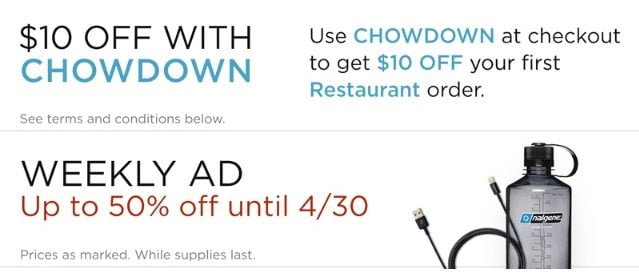
They offer a discount code and a date that it expires by. This is a classic e-commerce approach to using scarcity.
This is easy to implement, and of course, it has to be truthful. Don’t lie that a sale or time-sensitive deal is occurring if it isn’t.
Look at companies like Adidas. They intentionally limit certain footwear or products because it naturally creates scarcity. There isn’t enough to go around, so demand shoots higher than the moon.
Do you manufacture your own products? Consider releasing a limited edition product or line of items to test this for yourself. Add some urgency to your headline, and you have the golden ticket to more sales.
Avoiding mistakes or unpleasant situations
No one wants to keep running into the same problem.
David Eagleman, a neuroscientist at the Baylor College of Medicine, has spoken about and researched this extensively.
He stated that negative situations cause us to take action more quickly. How can you use this in a headline? By stating the reader’s problem like this:
- “Still in Student Debt? Learn How to Pay it Off in One Week”
- “5 Ways You’re Ruining Your On-Page SEO Without Realizing It”
- “Stop Making These Content Marketing Mistakes Today”
Use exact numbers or stats
Tell me what sounds better:
- “Learn How to Start an Online Business”
- “Learn How to Start an Online Shoe Business in 24 Hours That Can Generate $247/Day”
The second copywriting title is much more effective. It uses numbers to make it more descriptive and believable. This also aids in the reader understanding exactly what they are getting into, while the first headline is vague and could mean anything.
Internet marketing guru Neil Patel shows how to pull this off effortlessly. And no, I don’t mean that shirt.
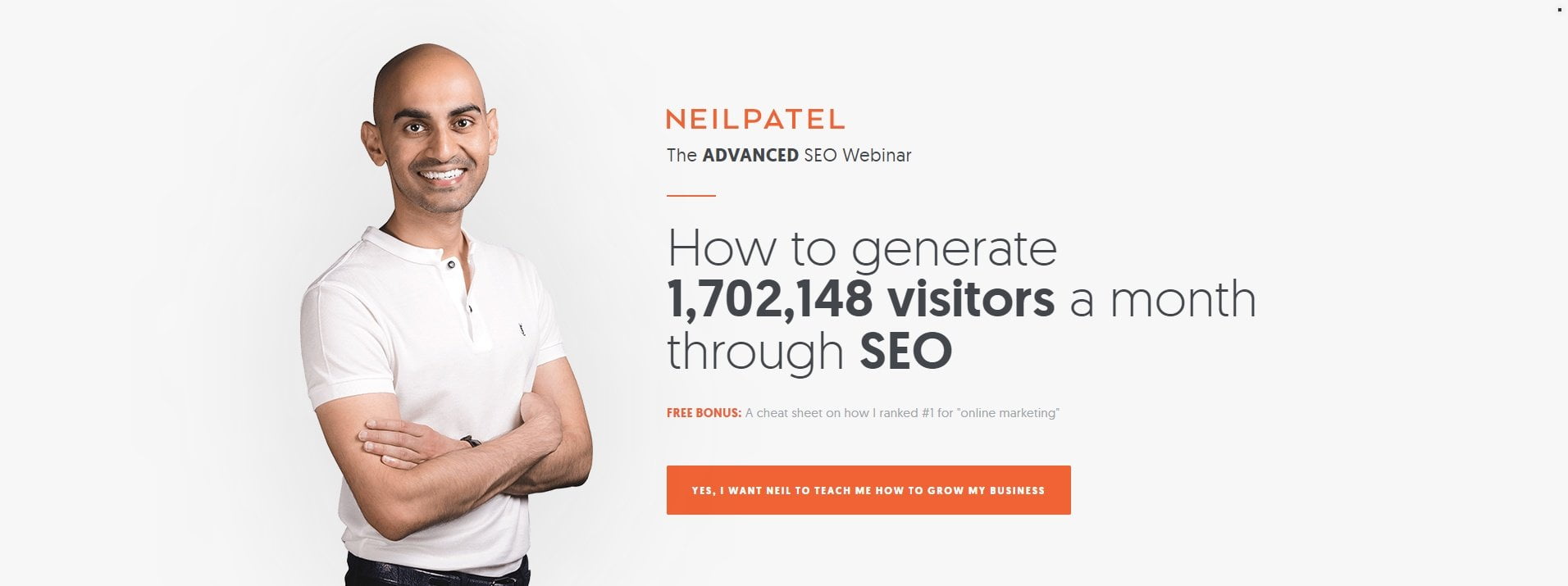
Use a concept or anchor
Another headline copywriting tip I have is using an anchor or concept. This is when you attach the main topic to an external force, such as:
- “How The Germans Took Over SEO”
- “Get Your Girlfriend Back With These 3 Texts”
In these examples, the main topics are SEO and getting your girlfriend back. But to make it more exciting, you add an anchor (3 steps) or a concept (The Germans).
For the first headline, the article might detail how German marketers found secrets to Google’s algorithm, and it exposes their strategies.
The second one would give the reader three templates for text messages they can send to their ex.
I love this example of concept copywriting from the watchmaker Omega.
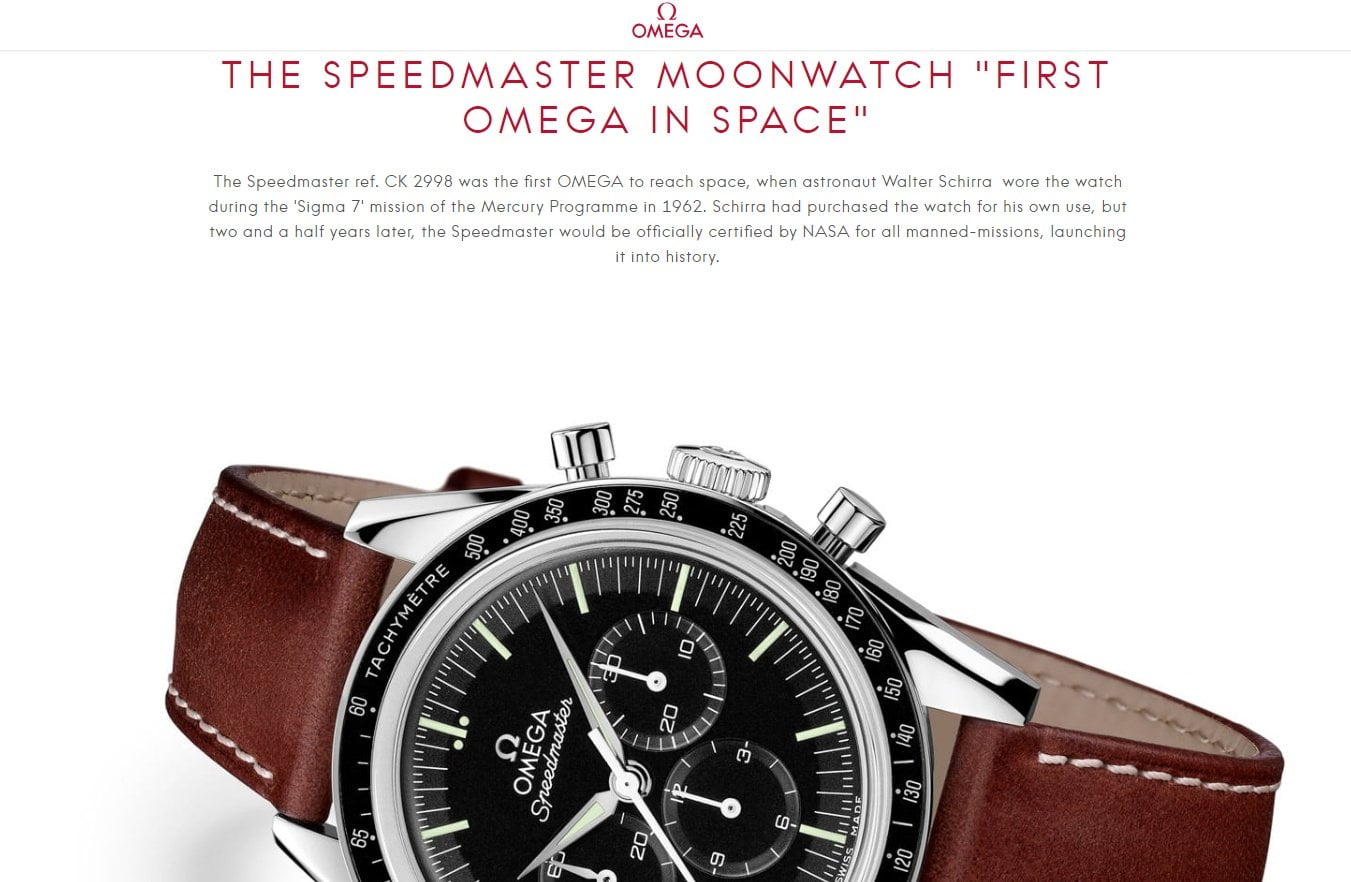
This watch model, the Speedmaster Moonwatch, was worn by astronauts that went into orbit. Thus, the “First Omega in Space” is very literal and makes an excellent concept headline. I would’ve done something like “One Step for Man, One Step for Omega.” 😉
Attention grabbing headline copywriting formulas
I’m going to include a swipe file at the end of this article, but these are some formulas you can use to put together your own headlines.
They are fill-in-the-blank style, so include your own topic, product, or ideas.
- Never Before Seen Insights into ___
- 10 Secret Tricks to ___
- Are You Making (This Mistake) That’s Leading to ___
- What ___ Doesn’t What You to Know
- Things We Learned From ___
- Myths You Probably Still Believe About ___
- Read What This Expert Has to Say About ___
- How I Increased My (Metric) by ___
- Do You Know These ___ Strategies?
- Stop Doing ___ to Improve (Metric)
Let’s also look at some literal formulas — copywriting equations, you can flesh out for yourself.
Pain + agitate + solve
A classic copywriting formula. I use this constantly, and it’s never failed to deliver great results.
While it truly shines when used for social media or articles, it’s a killer headline writing strategy, too.
The idea is that you take the pain point of a customer, agitate it, and then solve it. Here are some examples:
- “How Your Fear of Success is Delaying Your Dreams and What to Do About It”
- “Can’t Think of Article Ideas? Say Goodbye to Writers Block With These 5 Tips”
Before + after + how
This formula involves stating the current situation of the reader, what it could be like when improved, and how to get there.
It’s effective because it instantly tells the audience what to expect from diving into the rest of the copy.

Kevan Lee’s social media post shows how you can use this formula in the real world.
As a marketer, I understand that social media images do take a fair amount of time to create.
I don’t know about you, but when he says we can cut the design process from 1 hour to 15 minutes, I’m sold. It tells me exactly what I’ll learn from clicking his link and speaks to my existing experience.
The 7 deadly sins
No one is perfect. We all have our vices and make mistakes.
Remember that time you forgot to buy your little sister a birthday present, and she cried?
As a copywriter, you can take advantage of this.
The 7 deadly sins aren’t just religious teaching but a very applicable copywriting headline formula. Let’s take a deeper look at each of them.
Lust
Everyone desires something.
It could be attention, money, a nice body, or anything imaginable. You should know your customer well enough to have a grasp of what they really want.
This dating book is a good example.
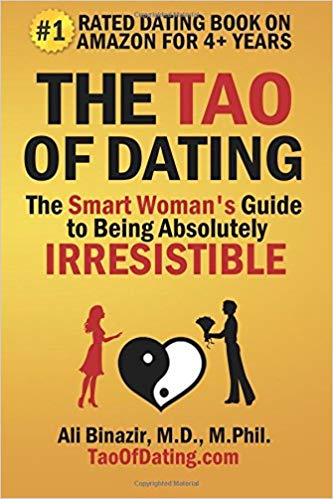
Note how the catchy headline reads “Guide to Being Absolutely Irresistible”. It’s playing on their target audience’s lust for love, attention, and affection.
It doesn’t just say “How to Be Attractive” but rather is appealing to the over-desire for men to be swooning over them.
Consider what lust your customers have and how you can intertwine it into your writing.
Gluttony
This sin is described as hoarding things for yourself. Do you remember this Lay’s commercial? I saw it all of the time as a kid.
The whole campaign is literally about not being able to have just a single chip. It’s one of the best ways gluttony has been used in marketing to date.
These are a couple of headline examples with this strategy:
- “Make So Much Cash From SEO That You’ll Make A Money Bed”
- “Look So Good That You’ll Make Every Woman in The Room Envious”
The general idea is to take what the customers want and multiply it by 100. It’s everything they dreamed of and more.
Greed
One of the easiest 7 deadly sins to pull off in copywriting, and it applies to many niches and verticals.
Does your product or service help the customer to generate more money? Then, bingo!
You have the perfect opportunity to craft headlines that speak to people’s greed. But don’t let that deter you from using it for other products.
Some individuals believe that having an abundance of health is being truly wealthy. Others might think the same for family, friends, or traveling.
The general idea is to speak to their innate need for an abundance of whatever they seek.
Sloth
The reality is that not a lot of people want to put in hard work.
They want the rewards and glamour right now.
Not in 10 months or 10 years, but in 10 minutes.
If your target audience has a knack for being impatient, it’s a great quality to target in your headlines. You see it all of the time.
“How to Get the Girl in 10 Minutes”, “Fix Your SEO in 5 Quick Steps”, or “This 15 Minute Trick Will Get You Ripped” are all simple but real-world examples.

Check out these YouTube headlines. People use them for one reason — because they work.
Wrath
We all get a little angry sometimes.
I bet you still recall the last time someone cut you off in traffic.
Anger and similar feelings are powerful emotions. Thus, they mix perfectly into copywriting. Consider these headlines:
- “Get Back At Your Friends Who Said You’d Never Be Rich”
- “Take Down and Fight Against the Corporations”
- “Don’t Let the Man Tell You What to Do”
All of these have one thing in common: opposition.
They imply that the customer is right, and justified and that there is another person holding them back.
Furthermore, this can tug on emotions and the primal reasons people are purchasing because it can be fueled by these reasons initially.
Envy
This is a two-way street.
You can use envy in your headlines either to make readers feel it themselves or communicate how they will make others experience it.
Consider the difference between these two examples:
- “Everyone Will be Watching You When You Drive The New Ferrari 488”
- “Learn How to Stop Wishing You Had Clear Skin With Our New Cream”
The first implies that other people will be envious of the customer.
The second implies that the customer is envious, but both use emotion to hook their attention.
Pride
People want to feel good when they buy a product or service.
They want to know that they are getting the best of the best.
Have you ever regretted a purchase? Try to avoid that with your customers.
You can apply this deadly sin to your headline by mentioning that the content it contains is secret, rare, only for experts, etc.
This way, readers will feel special when they consume it.
Going this route means that you will need to position the offer in a way that aligns with it.
Think about a private Facebook group, strategies nobody is talking about, etc.
How to write subheadings
What do you notice under every great heading? A subheading!
This is a place to continue to grab attention and make readers drool about a product or topic.
Look at this famous anti-wrinkle cream advertisement Gary Halbert wrote for illustration:
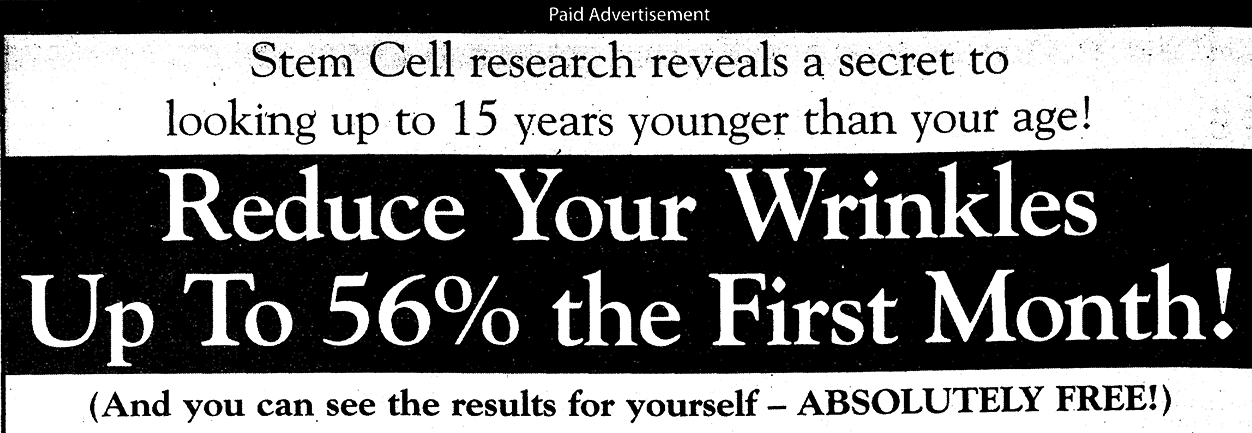
The headline is “Reduce Your Wrinkles Up To 56% the First Month!” with the subheadings:
- “Stem Cell research reveals a secret to looking up to 15 years younger than your age!”
- “And you can see the result for yourself – ABSOLUTELY FREE!”
The title is used to get the reader’s eyes glued to the page and interested. It offers a benefit (reduced wrinkles), a specific amount (56%), and a short time frame (First month).
The first subheading amplifies the benefit by telling readers they will look 15 years younger, while “Stem Cell research” creates interest.
Offering a sample of the product for free gets customers taking action and into the funnel.
And that’s exactly what a good subheading does: it amplifies the main message.
Use them to provide further context, information, and value.
How to write headlines for articles
Do you write blog posts or similar content? Then you must take the time to write a good headline, as it will increase the click-through rate.
A higher click-through rate results in more traffic for your website or landing page and can give a nice boost to your SEO.
WordStream found that higher-ranking websites on Google tended to also have higher CTR’s. Coincidence? I think not.
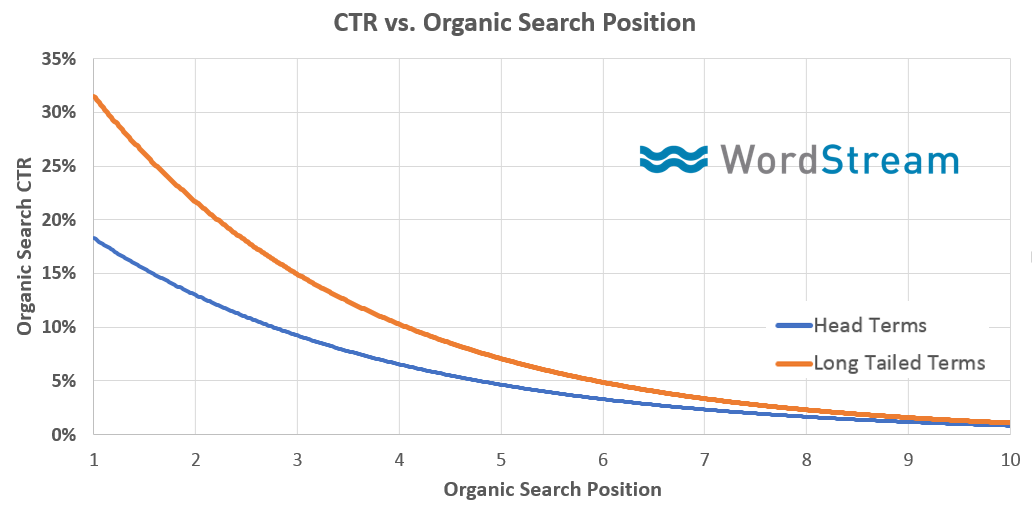
Contact me today if you require Toronto SEO services to take care of this for you.
Otherwise, here are some blog post headline tricks you can start using today to write epic article titles.
Editorial style headline
Shoutout to Buzzfeed. They are the first publication that comes to mind when I think of clickbait titles.
News headlines are ones like “You Won’t Believe What Happened Next” or “This One Simple Trick Will Shock You.”
They are one of the most effective types of headlines in copywriting.
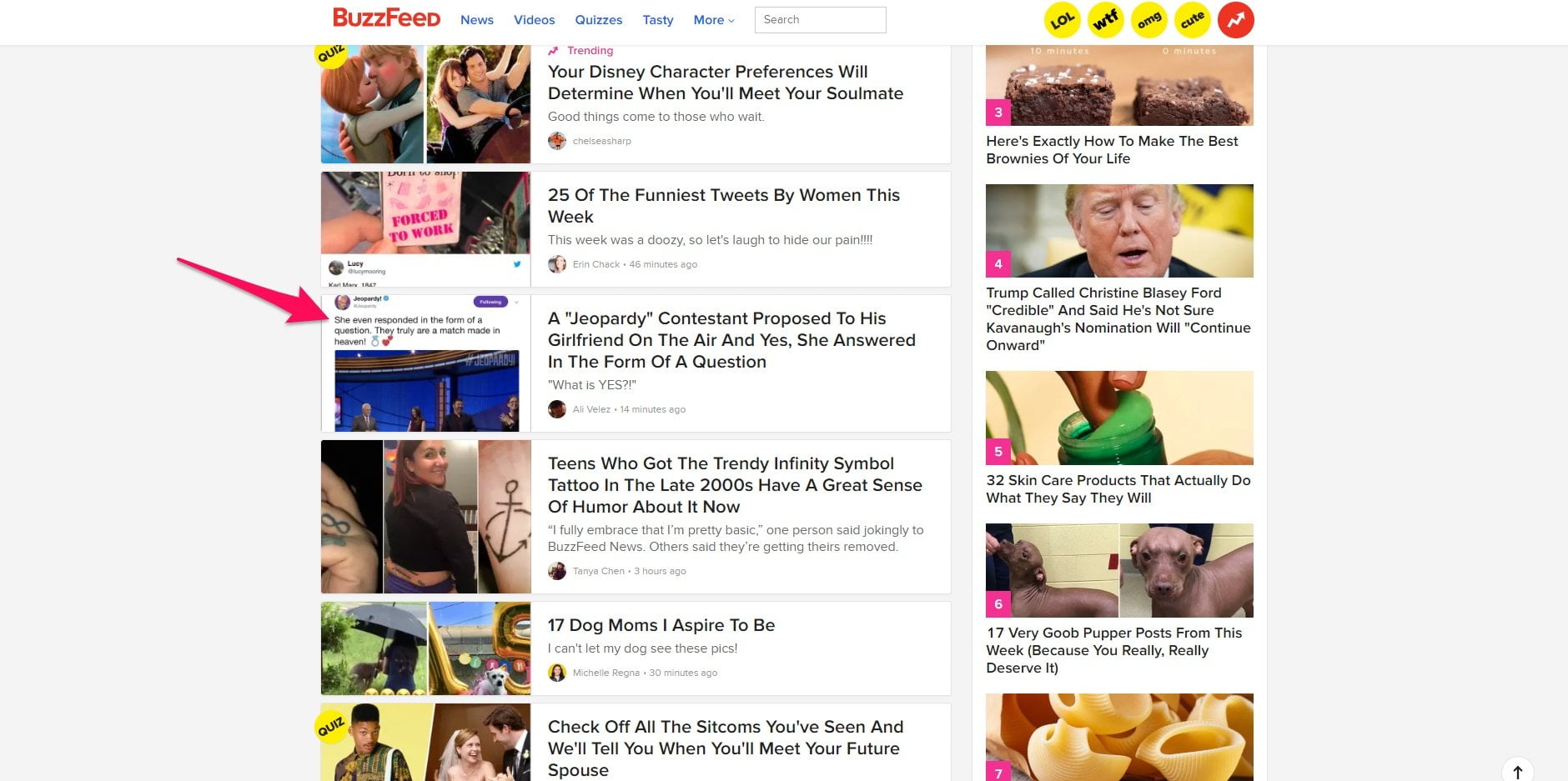
You practically can’t escape these titles.
Writers use them because they promote curiosity and emotion — the perfect cocktail for getting people to click.
The editorial style can be used for newspaper headlines, blog posts, and practically any piece of copy, however.
Use Why or How to start the headline
Using one of these two words in your article headline is a good emotional trigger.
They are normally followed by guides, strategies, or tips on something useful, like “Why Your Marriage Isn’t Working The Way You Want it To” or “How to Start a Business for Under $50.”
This approach works so darn well because readers instantly get an idea about what they are going to learn and what problem will be solved.
Throw in a recognizable name
If your article is going to involve interviews, quotes, or similar features, this is an easy one.
Mention the name of a famous or credible individual in your vertical.
Imagine that you saw an article titled “Obama Says Icecream is Gross” — you’d probably click it because it’s a universally recognized name.
Why does this work?
Simply because of influencer marketing.
I.e. Placing people with large and loyal audiences into your copy or campaign.
In fact, interest in influencer marketing has risen more than 90% since 2013. It’s no surprise why.
It doesn’t just have to be an individual person, though.
It can also be a reputable institution, study, or university.
All of these build trust and establish authority with the audience.
How to write social media headlines
Writing headlines for social media involves everything that you’ve learned so far.
Citing stats, taking advantage of anchors, agitating problems, and all of the other tactics all work.
Here’s the biggest problem that I see writers making on social media, though.
They don’t use calls to action.
A beautiful headline is nice, but you need to tell the user what to do next. Which in most cases is to click a link.

You don’t have to overthink a call to action, either. They are basic. Think “Click now”, “Learn here”, or “Click the link below”.
When you are writing a social media headline, I’d also recommend asking a question. This gets other users to engage, gets them invested in the conversation, and also attracts other people.
Copywriting headlines swipe file
Alright, I promised you that I would include a headline swipe file, and here it is! Fill in the copywriting headline templates as needed.
- Your ___ Doesn’t Want You to Know About This
- You Can Get Ripped in 15 Minutes by ___
- Would You Like to Have ___ ?
- World’s Best ___ Teaches You How to ___
- Why Are You Doing ___ When You Can Be Doing ___
- Are You Still Doing __ ?
- Have You Ever ___ ?
- What The Taxman Won’t Tell You About ___
- The Secret That The ___ Are Hiding
- What Every Beginners Needs to Know About ___
- Every Beginner ___ Makes These Mistakes
- Every Pro ___ Has These Habits
- Turn Your ___ Into a ___
- Too Busy ___ to ___ ?
- 5 Things You Never Thought About ___
- Tired of ___ ?
- If You’re Reading This and Do ___ Stop Right Now
- The Ugly Truth About ___
- What Nobody in ___ Wants to Speak About
- The People Who Did ___ Became Millionaries
- You Won’t Believe How ___ Works
- Sick and Tired of ___ ?
- Own The Business Of Your Dreams While Sleeping in Until Noon
- No Phones – No Staff – No Meetings – Just Pure Passive Income
- New Super Food Tested by Navy Seals Just Revealed
- Man Who Spent 3 Years In a Wheelchair Now Runs Five Kilometers a Day
- Improve Your Grades in as Little as 5 Minutes a Day
- I Discovered How to ___ Now I’m Revealing
My Secret - How to Use ___ For ___
- How to Turn ___ Into ___
- Are You a ___ ?
- Are You Still Tying to ___ ? Then You Need ___
- $500 Per Day With Just $20
Final thoughts on how to write headlines
Headline copywriting is one of the most useful skills you can develop as a writer.
There are so many writers out there that neglect their headlines and suffer as a result.
Nobody clicks through to tread their content or copy, and that means no sales can happen. 🙁
Heck, I’ve been doing a content audit on my site by simply increasing the click-through rate of my blog post titles, and it’s been amazing!
Reach out to me today if you need a copywriter for hire to take care of your headline writing needs. You can also enroll in my courses to learn more.
Alternatively, apply today’s main takeaways to write great headlines that make customers itching to buy:
- Take advantage of urgency and scarcity to make readers want to take action in fear of missing out.
- Mention how the product or service will help them avoid unpleasant situations and their main pain point.
- Use exact numbers in the headline to avoid being vague.
- Attach your headline to a concept or anchor to make it more appealing.
- The classic pain + agitate + solve formula is very effective for headlines and many places within a project. This involves bringing up a pain point, agitating it, and positioning you as the solution.
- Buffer’s before + after + how is another incredibly effective copywriting formula. This involves stating the current situation, how it could be better, and explaining how it can be done. Once again, this allows you to hit on emotional points and position yourself as the way to get across the “bridge.”
- Use the seven deadly sins like gluttony, greed, lust, sloth, wrath, envy, and pride.</li>














